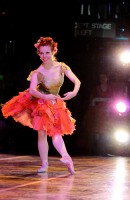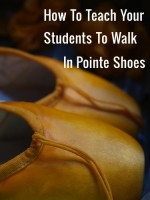I remember one of my first teachers telling me that two of the hardest things in ballet to do well were walking and running.
Now, after years of teaching, I have to agree with her!
When done well, an audience rarely notices a dancer walking, in that it seamlessly blends into the rest of the piece as a dance movement in its own right. What you don’t want is for dancers to slip from ‘ballet mode’ into ‘walking down the street mode’ half way through a dance, thereby ruining the overall effect.
Below are some tips to help all dancers improve their classical walks, but more specifically, to teach inexperienced pointe students how to walk elegantly in their new shoes.

Like any movement in ballet, walking has to be practiced.
Explain and demonstrate exactly what you want from the beginning. You are more likely to get a good result, and faster.
Get students walking in their pointe shoes as soon as they are in them.
Don’t think you have to wait until relevés and échappés are perfected, and don’t wait either until assembling show choreography – this is much too late if you want a polished performance.
Break down precisely what walking entails.
This may sound silly, but due to their thicker soles (incorporating the hard shank), additional overall ‘bulk’ and comparative rigidity, learning to walk in pointe shoes should be considered a separate skill, and taught as such.
Regardless of how good their walks are in soft shoes (‘flatties’), I recommend always commencing students pointe training with a refresher ‘break down’ to reintegrate any details lost, and get them used to articulating their feet inside their pointe shoes.

In terms of the types of walking most commonly found in the classical repertoire, this can broadly be split into classical walks, and walking en 3/4 pointe. I recommend first teaching the former.
The Classical Walk
In order to focus their minds upon the details of the action to be incorporated or reintroduced, I recommend stripping the movement right down to the basics.
Talk the dancers through each action, then get them to practice the following sequence in slow motion; all the while taking care to place each part perfectly in order to develop good muscle memory.
Here are the actions broken down:
- Commence dégagé devant,
- Fully articulating the front foot (through the toes, ball of the foot, to heel), place the foot turned-out flat on the floor, whilst transferring the weight to a small plié in 4th position,
- Fully articulating the back foot, and using a small ‘push off’ of the back foot in order to help give impulsion, transfer the weight to dégagé derrière,
- Lift the toes of the back leg just off the floor then, keeping it fully stretched and low so as to skim just above the floor’s surface, draw the foot in to sur le cou-de-pied (remembering to pay close attention to turnout so as to lead with the toes not the knee),
- Unfold the working leg from sur le cou-de-pied to dégagé devant, keeping the toes low to the ground so as to again skim just over the floor.
Once this has been established, I then ask the dancers to gradually speed-up and smooth-out the action, so that the details remain, but it looses that ‘staccato’ appearance.
Usually this is practiced in a circle round the room, the students working at their own pace (being free to overtake when required!), to some fluid background musical accompaniment.
Common things to keep an eye out for are:
- Drawing the working foot up to close to retiré instead of keeping it low – skimming just above the floor and drawing it through sur le cou-de-pied
- Not fully articulating/stretching the back foot or straightening the back knee for dégagé derrière
- Making the plié too large or jerky thereby creating a ‘bobbing’ appearance
- Loosing turnout of the working leg when changing from dégagé derrière to sur le cou-de-pied
- Not sufficiently anticipating the forward movement so the legs appear to move before the body ‘gets there’ thus creating a ‘body roll’ appearance.
Bonus Tip:
When working on either type of walk I find it particularly useful to show students video footage of professional dancers as this seems to help them really observe and internalise how the separate components can be present, whilst still creating a fluid, seamless action.
When teaching classical walks, one example you can use is the entrance of the corps de ballet for the Kingdom of the Shades from the ballet ‘La Bayadère’, such as this rehearsal and performance footage of the Boston Ballet’s 2010 version.
La Bayadère: The Kingdom of the Shades
Troubleshooting
If their weight is back, they are having problems anticipating the forward movement or getting ‘over their leg’ after the transfer of weight to dégagé derrière.
- Suggest they imagine they are being pulled by an imaginary thread from their sternum so as to help better anticipate and accommodate the transfer of weight. In addition, you can temporarily add in a tiny lift of the back toes just off the floor in dégagé derrière, to help them actualise the concept of being right over their front leg by the time they hit dégagé derrière, and not afterwards.
Dancers are ‘getting stuck’ in the plié.
- Remind them that it should remain comparatively small, and also explain to them that the plié is only in the break down to a) encourage a thoughtful transfer of weight, b) to afford them the time to concentrate on fully articulating their feet, c) help promote a small ‘push off’ of the back foot into the dégagé derrière which helps give impulsion.Once the movement is being practiced as opposed to analysed, this plié should therefore be transformed into a gentle flexing of the knees, and ultimately ‘disappears’ as points 2-3 become sufficiently blended that it is only one overall transference of weight – from dégagé devant, to dégagé derrière.
Once the steps are sufficiently smooth, I work with the students on making the movement look light and well coordinated; keeping the hips forward and reminding them to really use their arms, head and eyes to complete the action.
A chance to incorporate artistry, performance and musicality
We discuss impetus and dynamics, and how, for instance, the movement may convey sadness or longing if performed in a slow and indulgent way (really drawing out the transfer of weight), or illustrating determination or passion if the transference of weight is quickened and there is a short pause held in dégagé derrière.
Walking en Three-Quarter Pointe
The second type of walk is often executed to quickly cover ground (often walking ‘through the music’), or to enter on stage to commence a performance piece.
How it differs from the classical walk

The legs are held slightly straighter, and the transfer of weight is minimised so as to become only a tiny softening of the knees (more similar to bourrées/courus in that sense).
The action of the feet is also different in that, excepting the first and last steps of a sequence, the feet are not placed flat on the floor but instead operate only between 3/4 pointe when weight-bearing, and fully stretched when non-weight-bearing.
Two essentials for making this movement work
- Care must be taken to keep the weight ‘on the legs’ i.e. the head held over the hips and the hips over the toes, with the dancer fully anticipating the forward motion of the body. No leaning back.
- The ankles should remain fully extended so the heels remain high off the floor.
As the individual components of walking en 3/4 pointe are simpler than those of classical walks, such a detailed break down is not required. That said, it is important to discuss with students the above differences between the two types, what in particular is expected of them when walking en 3/4 pointe, and for them to practice this step as a practical exercise in its own right.
For showing dancers walking en 3/4 pointe within the context of a classical ballet, there are many examples during the Fairies entrance (1:10) in the Prologue of ‘The Sleeping Beauty’, as shown in this version from the Royal Ballet’s 2007 production.
The Sleeping Beauty Royal Ballet
Common things to keep an eye out for are:
- The heels being too low to the ground (1/4 pointe more than 3/4 pointe)
- The toes not being fully stretched when non-weight-bearing, making the step look inelegant and slightly clumsy
- The back foot rolling down from 3/4 pointe to 1/4 pointe in between each step, so as to create a ‘bobbing’ appearance
- The weight held back, so the dancer feels they can’t ‘free’ their legs; often simply looking awkward or unable to establish impetus/momentum.
How to produce a clean, controlled and elegant ending
Once students really get the hang of walking en 3/4 pointe, take the take time to examine how to take the first and last steps of a sequence, as breaking this down can be invaluable in creating a uniformed corps and confident dancers.
I teach students to complete a sequence of walks en 3/4 pointe with one classical walk, whereby they finish the second-to-last last step en 3/4 pointe by rolling down to flat with a tiny fondu, before taking one classical walk from dégagé derrière to dégagé derrière.
Details can transform an average group of dancers from looking amateurish to brilliant.
After viewing countless student performances I am convinced of this.
By taking the time to really analyze the details of walking in ballet you are one step closer to developing a truly professional aesthetic.
Which concepts do you find most difficult to teach in ballet?
Angeline Lucas is a freelance dance writer, teacher and lecturer based in England. She has been awarded Registered Teacher Status with the Royal Academy of Dance (RAD) and is an Approved Teacher of the Council for Dance Education & Training (CDET). Angeline trained at Northern Ballet School (NBS) and holds a Certificate of Higher Education in Dance Education, validated by RAD and the University of Surrey. Previous roles have included working as head of department, outreach coordinator and curriculum manager, and she also has experience in dance research and arts administration. Angeline has taught and lectured at various private dance studios, schools, colleges and on community programmes, and is considered to be a dedicated, experienced and enthusiastic teacher. Angeline’s greatest passion is classical ballet, and is devoted to the advancement of the art form, the promotion of accessible high-standard dance education, and facilitating the achievement of her students.

